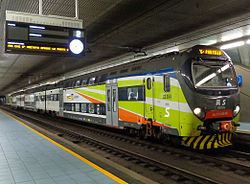Daily ridership 165,000 System length 359 km (223 mi) Number of lines 12 Transit type Commuter rail Operator Trenord | Number of vehicles E.464, TAF, TSR Locale Milan Number of stations 125 Began operation 2004 | |
 | ||
Host railroads Rete Ferroviaria Italiana, Ferrovienord Headway up to 6 minutes in the central track Track gauge 1,435 mm (4 ft 8 ⁄2 in) standard gauge | ||
The Milan suburban railway service is a commuter rail system serving the metropolitan area of Milan, Italy. The system comprises 12 lines serving 125 stations, for a total length of 403 km. There are 415 trains per day with a daily ridership of about 165,000.
Contents
The core of the system is the Passante, an underground railway running through the city approximately from the north-west to the south-east. Several lines share this track, making the service in the city centre comparable to a metro line.
The service timetable is based on a clock-face scheduling. Although operated by different companies, the Metro and the suburban rail service have integrated tickets.
Network
Lines in darker background run through the Milan Passante railway.
Lines which share same tracks for the majority of the route are generally identified by similar colors.
The line number S10, formerly used for a part of what is now line S13, has been unused since 2011 to avoid confusion with line S10 of the Canton Ticino commuter rail.
Lines
Trains run every 30 minutes in each line, generally from 6 am to 9 pm or midnight depending on the line.
Integrated ticketing
An integrated ticket is used inside the Milan urban area for bus, tram and metro lines, as well as the suburban railway. The urban single journey ticket costs €1.50. Other tickets are available, including 24h and 48h tickets and night ticket. Regional train fares apply outside the urban limit.
Between 2004 and 2007 ATM introduced Itinero smartcard, a proximity card which can be charged with season tickets, replacing paper for this type of tickets in the Milan area. At the beginning of 2010, a new smartcard, RicaricaMi, was introduced. The new card can be charged up with credit and can be used for travel in place of magnetic paper tickets, on the model of London's Oyster card. These cards are also valid on the suburban railway lines.
The suburban railways can be accessed also with the regional integrated ticket "Io viaggio ovunque in Lombardia", as 1 to 7 days tickets or more long subscription with smarcard "Io Viaggio".
Rolling stock
Several train classes are operated on the network. TAF (Treno Alta Frequentazione) class trains were introduced since the end of the 1990s. Trenord is now introducing new Treno Servizio Regionale (TSR) class trains to replace older rolling stock. On the S9, S11 and S8 are the Vivalto train and the double decker train
History
Full service started on 12 December 2004 with the completion of the Passante and the activation of the first 8 lines. However, a shuttle service was running since 1997 in the partially completed track.
Line S4 was extended from Seveso to Camnago on 19 February 2006. The new Romolo station on line S9 was opened 3 months later. Lines S1, S2, S6 and S10 were extended from Porta Vittoria to the new station of Rogoredo on 15 June 2008.
Two new stations, Pregnana Milanese and Rho Fiera Milano were opened in 2009. Line S8 and S11 began operation at the end of the same year, while the service was extended to reach Lodi and Treviglio.
On 26 March 2011, with the completion of the Milan Metro Line 3 north extension, a new station, Affori, was opened in place of the old one, to be an interchange with the Metro.
On 1 May 2011 a new company, Trenord, was created from the joining of the two main regional train operators in Lombardy, Trenitalia and LeNord. Trenord is since then the operator of most of suburban lines.
Planned extensions
At least one new line are expected to enter service in the next years:
Several new stations are also planned for the Milan urban area: Milano Tibaldi, the renewed Milano Porta Romana and others.
